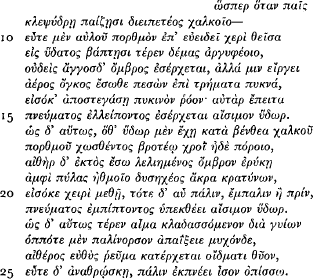Article contents
A Mistake to be avoided in the Interpretation of Empedocles fr. 100.
Published online by Cambridge University Press: 23 December 2013
Extract
Dr D. O'Brien in his interesting article ‘The effect of a simile: Empedocles's theories of seeing and breathing’ (JHS xc [1970] 140–79) unfortunately reverts to D. J. Furley's view that, in the clepsydra simile of Empedocles fr. 100, air must be parallel to air and water to blood. This involves him in interpretations which have no basis in the text of Empedocles. It is obvious, from the clear parallelism of sentence structure presented by Empedocles and duly noted in my article of 1960, that water is parallel to air, and air to blood. The relevant lines are (as quoted from Ross by Dr O'Brien):

The general sense is:
Just as, in the case of the clepsydra, water comes in and out through the sieve in accordance with movements of air on the other side of the sieve:
So, in the case of breathing, air is breathed in and out through holes at the back of the nostrils in accordance with movements of blood on the other side of the holes.
- Type
- Notes
- Information
- Copyright
- Copyright © The Society for the Promotion of Hellenic Studies 1976
References
1 Furley, D. J., ‘Empedocles and the Clepsydra’, JHS lxxvii (1957) 31–4CrossRefGoogle Scholar.
2 Booth, N. B., ‘Empedocles' Account of Breathing’, JHS lxxx (1960) 10–15CrossRefGoogle Scholar. Throughout the present note I have assumed as correct the interpretation of ῥινῶν as ‘nose’, for which arguments are presented in my earlier article; but the argument of this present note does not depend in any way on that assumption.
3 See my article in JHS (1960) 13, lines 24–35, where I have argued that we are not to expect that all details of the clepsydra analogy should be relevant to the comparison. (This argument disposes also of Dr O'Brien's criticism of my interpretation on the grounds that I have got things ‘somehow upside down’; see p. 152 of his article.)
4 I would commend other scholars like Professor W. K. C. Guthrie, Dr G. Lloyd and Professor G. A. Seeck who have not followed this error and who have been kind
- 1
- Cited by




